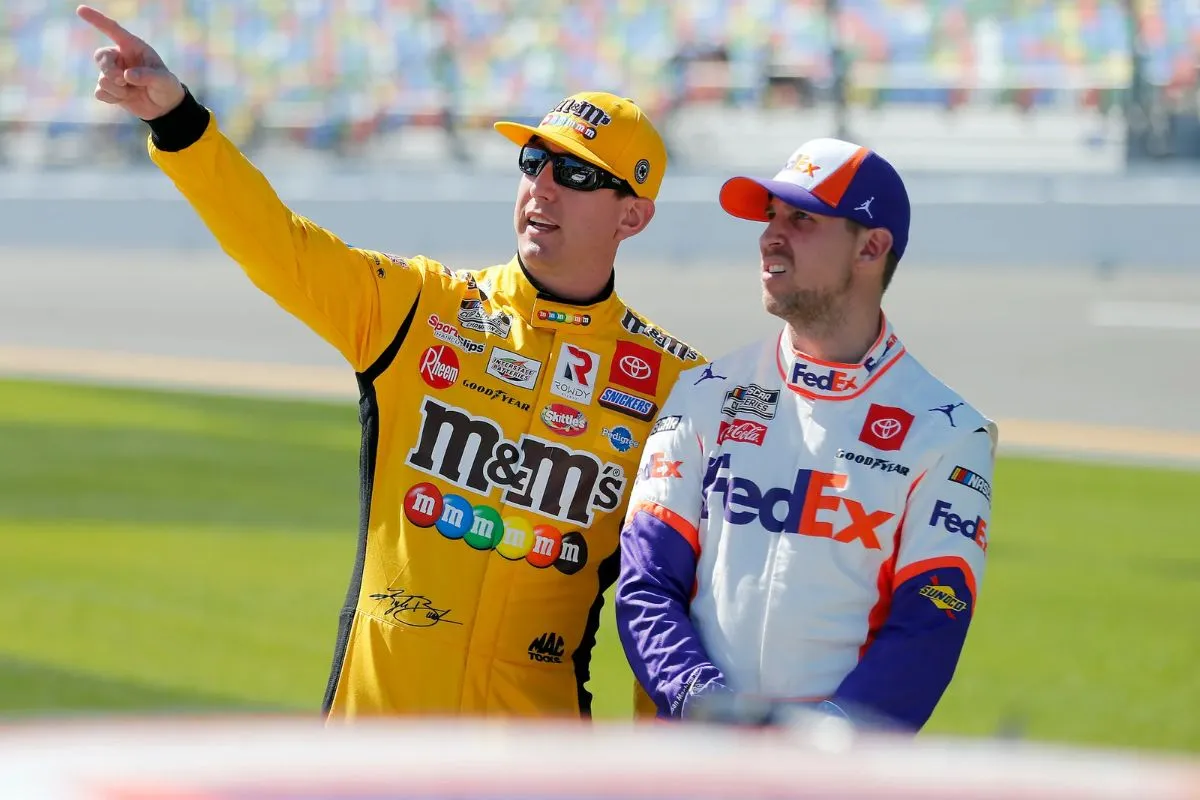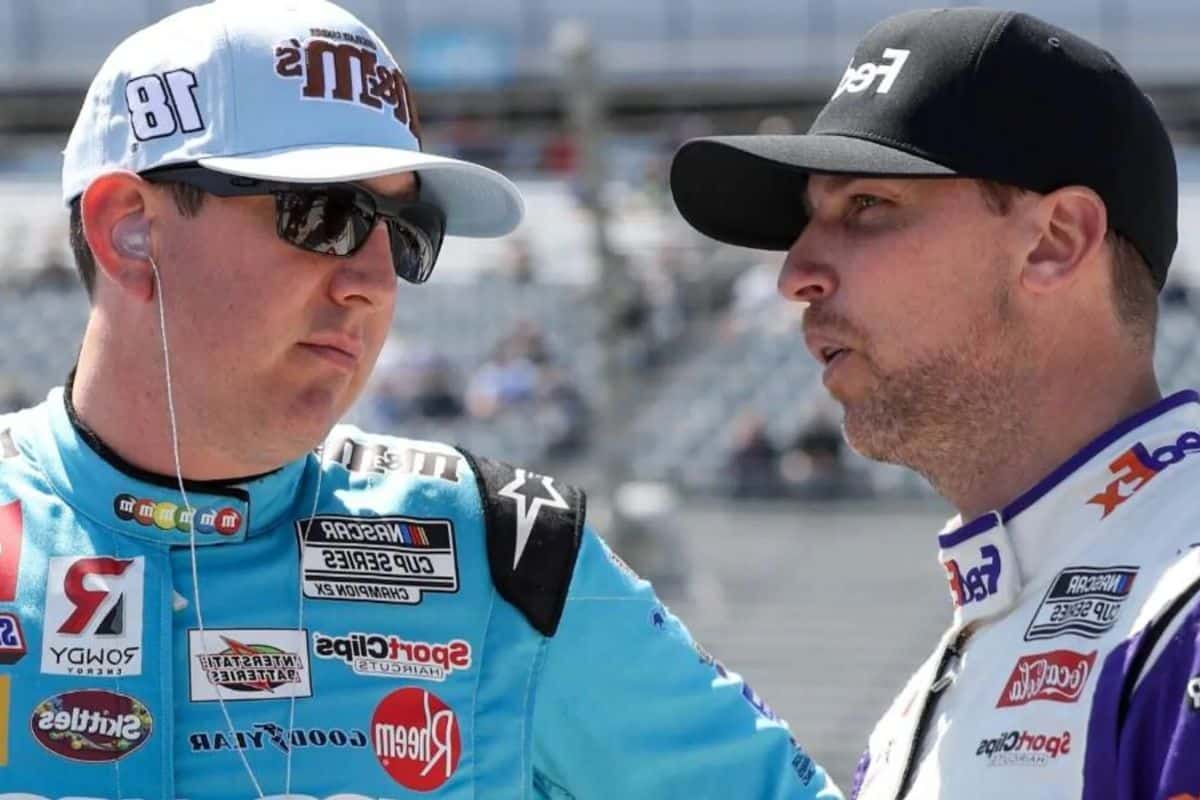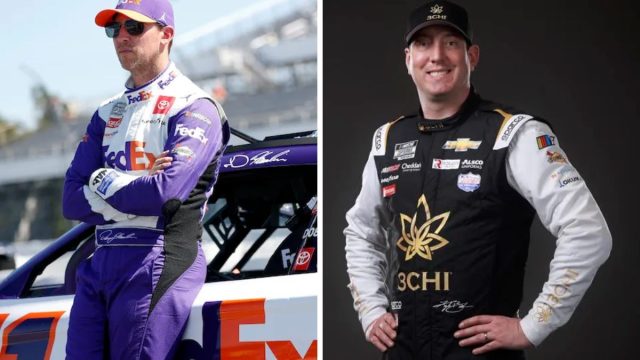Kyle Busch Defends Denny Hamlin: In the wake of Kyle Busch’s defense of Denny Hamlin following the controversial restart at the Toyota Owners 400, the motorsports community finds itself at a crossroads, deliberating on the essence of racing strategy versus the compliance of the rulebook. Busch’s viewpoint not only supports the ingenuity shown in top-level competition but also highlights a bigger discussion about how NASCAR’s rules can be understood differently by different people. This incident invites enthusiasts and experts to ponder whether the actions on the track represent a breach of conduct or a masterstroke of tactical prowess. As this discussion continues, it beckons a closer examination of the fine margins that define the spirit of competitive racing.
Key Takeaways
- Kyle Busch supports Denny Hamlin’s controversial restart, viewing it as a tactical strategy rather than a rule violation.
- Busch emphasizes the importance of understanding elite-level racing dynamics in assessing Hamlin’s actions.
- The incident sparks debate on NASCAR rule enforcement consistency and the fine line between strategic innovation and adherence to regulations.
- Comparisons are drawn with past racing incidents, highlighting the evolving nature of competitive strategies and their reception within the community.
- The controversy prompts discussions on the potential need for clearer race restart rules to avoid ambiguities and ensure fair competition.
Denny Hamlin’s Controversial Restart
Denny Hamlin’s controversial restart during the Toyota Owners 400 at Richmond Raceway has ignited a fervent debate among NASCAR enthusiasts and experts, scrutinizing the motives behind his premature acceleration ahead of the designated restart zone. The incident has not only spotlighted Hamlin’s decision-making in critical race moments but also raised questions about the consistency of rule enforcement in the sport. As the No. 11 JGR driver, Hamlin’s actions on the track are under intense observation, especially given his history with fans and competitors.
The majority of NASCAR experts and seasoned observers have analyzed the situation, offering a spectrum of interpretations. Some view Hamlin’s early acceleration as a calculated risk, a momentary decision made in the high-pressure environment of competitive racing. Others, however, question the fairness and sportsmanship of such a move, suggesting it supports the integrity of the race and potentially sets a controversial example for the future competitions. This divide in opinion shows the complexity of NASCAR’s racing dynamics, where split-second decisions can have far-reaching implications for drivers and their teams.
Moreover, the incident has sparked a broader discussion about the clarity and application of NASCAR’s rules regarding restarts. The debate extends beyond Hamlin’s actions, touching on the need for transparent and consistently applied regulations that maintain a level playing field for all competitors. As the conversation continues, the NASCAR community is confronted with the delicate balance between strategizing within the rules and the overarching principles of fair competition and sportsmanship.

Kyle Busch’s Defense of Denny Hamlin
Entering the heated debate, Kyle Busch articulated a defense of Denny Hamlin’s controversial restart strategy, emphasizing it as a tactical necessity in the face of competition from notable drivers like Joey Logano and Martin Truex Jr. Busch’s perspective offers a distinct understanding of the dynamics at play in elite-level racing, where split-second decisions can often mean the difference between victory and defeat. His comments suggest a broader conversation about the strategic complexities inherent in motorsports, where the interpretation of rules can vary widely among participants and spectators.
Busch’s stance is not just a simple defense of a fellow driver but appears to be rooted in a deep understanding of the competitive pressures that shape drivers’ actions in high-stakes situations. He implicitly raises questions about the balance between strict adherence to rules and the need for strategic innovation that can sometimes push the boundaries of those rules. This shows an ongoing debate within racing circles about the nature of competition and how it should be regulated to maintain both fairness and excitement.
Busch’s Explanation and Justification
In a conversation with Kenny Wallace, Busch initially took a hard line, arguing that the rules are clear-cut and that the No. 11 driver’s jump on the restart warranted reprimand. However, his stance quickly shifted as he absorbed the insights shared by Steve Letarte and Todd Gordon via NASCAR’s social media channels. Suddenly, Busch found himself justifying Hamlin’s preventive actions, seemingly swayed by the distinct explanations provided by the experts.
This justification speaks to the complexity of racing strategy and the split-second decisions drivers must make. According to the experts, Hamlin’s actions, though seemingly preventive, were a calculated risk within the competitive context. Busch’s defense, therefore, positions Hamlin’s move not as a blatant disregard for the rules but as a sophisticated racing strategy, highlighting the intricate balance between strict rule adherence and the competitive instincts of elite drivers.
Busch’s argument shows the importance of contextualizing race actions within the broader tactical landscape, advocating for a more distinct interpretation of racing rules. This perspective invites a deeper appreciation for the strategic dimensions of motorsports, where decisions are not merely black and white but are influenced by many factors that demand mastery from both drivers and their teams.
“They are all trying to time that roll and momentum because they know the restart zone where it is. So as the leader, you’re already kind of at a disadvantage… Denny is very smart, he’s very calculated, and he understands a lot of things very well. He is probably looking in his mirror or looking in his rearview screen and seeing this happening around him and seeing it develop. So he wants to go early to put those guys back on their heels, and I believe that’s what he did.”
“It was all defense, you know. Like I said, as the leader you have the advantage of being able to restart when you want to restart. But unfortunately, it’s in a zone so they know that you’re going to go within that zone, and with these cars and everything all being so similar it’s not like restart ratios you can have any sort of advantage. You’re all with the same stuff.” – (Kyle Busch)

Comparison with Past Incidents
In examining the controversial decision by Denny Hamlin, Kenny Wallace reflected on a similar incident from 2016, where Joey Logano’s tactical maneuver led to Carl Edwards’ crash during a race restart, shedding light on the recurring strategic complexities within motorsports competition. This parallel draws attention to the fine line between aggressive racing tactics and the boundaries of fair competition. The incident involving Logano and Edwards was controversial, sparking debate about the ethics of racing strategy and the implicit rules of engagement among drivers. It highlighted the intense pressure on racers to secure victories, sometimes pushing the envelope of accepted norms and regulations.
The Ford EcoBoost 400 showcased the intensity of Denny Hamlin’s strategic maneuvering. With just 10 laps remaining, Carl Edwards led the pack with Logano hot on his tail. As they approached the restart zone on the front stretch, Edwards fought to fend off Logano’s relentless pressure. Yet, Logano’s aggressive push propelled the No. 19 car into a chaotic pile-up, shattering Edwards’ car and championship hopes. The damage rendered his car irreparable, marking a devastating DNF and a heartbreaking setback in his pursuit of the championship title.
Tragically, the Ford EcoBoost 400 marked the final NASCAR Cup Series race for Carl Edwards, who opted to retire after the 2016 season. While Edwards bid farewell to the track, Jimmie Johnson seized the moment and etched his name into the annals of history by clinching an extraordinary seventh Cup Series championship at Homestead. It was a momentous triumph for Johnson, solidifying his legacy as one of the sport’s greatest drivers. However, the victory was not without suspense, as Logano narrowly missed out on his shot at glory, finishing in fourth place and securing a commendable second in the overall championship standings, just behind the legendary Johnson.
Potential Consequences and Reflection
Reflecting on Denny Hamlin’s decision to jump the restart in Richmond, it’s important to ponder the potential ramifications this action might have on his reputation, the perceptions of his peers, and the broader implications for the sport’s regulatory standards. While Kyle Busch’s defense positions Hamlin’s maneuver within the scope of strategic racing, the incident beckons a closer examination of where the line between strategy and rule infraction lies.
In the sport of professional auto racing, actions on the track are scrutinized thoroughly. Hamlin’s decision, though possibly a tactical move to avoid a ‘tragic end’ to his race, raises questions about the fairness and integrity of competition. If one driver’s strategic advantage comes at the cost of bending established rules, it sets a precarious example. This incident could lead to a pivotal moment where NASCAR and its governing bodies might feel compelled to tighten regulations or clarify existing ones to uphold a level playing field.

News in Brief
The defense of Denny Hamlin by Kyle Busch in the aftermath of the controversial restart at the Toyota Owners 400 shows the intricate balance between strategic innovation and adherence to rules within NASCAR.
This incident illuminates the complex dynamics of competition regulation in motorsports, demanding for a distinct interpretation of racing regulations.
It also highlights the camaraderie among drivers, emphasizing the significance of understanding and respecting the strategic decisions made on the track, thereby enriching the discourse on competition regulation in elite racing.
Also Read: Kyle Busch’s Take on Denny Hamlin’s Move: A NASCAR Controversy Revealed
